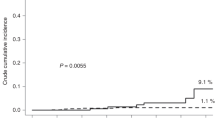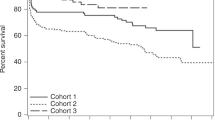Summary:
To evaluate the incidence, risk factors and prognosis for solid tumors after hematopoietic stem cell transplantation (HSCT) in Japan, 809 patients who had received HSCT between 1981 and 2000 were retrospectively analyzed. In all, 19 newly diagnosed secondary cancers were observed. The risk for cancer development was 2.8 times as high as that for expected cases. The cumulative incidence ratios at 5 and 10 years were 1.9 and 4.2%, respectively. The risk was significantly elevated for buccal cavity cancer (standard incidental ratio (SIR), 44.42: 95% confidence interval (CI) 17.86–91.51), esophageal cancer (SIR, 22.36: 95% CI 6.09–57.25), and cervical cancer (SIR, 8.58: 95% CI 1.04–31.01). Of 15 patients who developed solid cancers following allografting, 12 had chronic graft-versus-host disease (GVHD), and all 10 patients with squamous cell carcinoma of the buccal cavity or esophagus had chronic GVHD. On multivariate analysis, extensive chronic GVHD and age over 45 years at the time of transplantation were associated with a higher risk for solid cancers. In all, 17 patients received therapy for secondary cancers, nine of whom are still alive and the 5-year probability of survival from the diagnosis is 42.8%. Our data suggest that early detection of secondary cancers is very important in prolonging overall survival.
This is a preview of subscription content, access via your institution
Access options
Subscribe to this journal
Receive 12 print issues and online access
$259.00 per year
only $21.58 per issue
Buy this article
- Purchase on Springer Link
- Instant access to full article PDF
Prices may be subject to local taxes which are calculated during checkout


Similar content being viewed by others
References
Curtis RE, Rowlings PA, Deeg HJ et al. Solid cancers after bone marrow transplantation. N Engl J Med 1997; 336: 897–904.
Witherspoon RP, Fisher LD, Schoch G et al. Secondary cancers after bone marrow transplantation for leukemia or aplastic anemia. N Engl J Med 1989; 321: 784–789.
Deeg HJ, Socie G . Malignancies after hematopoietic stem cell transplantation: many questions, some answers. Blood 1998; 91: 1833–1844.
Micallef IN, Lillington DM, Apostolidis J et al. Therapy-related myelodysplasia and secondary acute myelogenous leukemia after high-dose therapy with autologous hematopoietic progenitor-cell support for lymphoid malignancies. J Clin Oncol 2000; 18: 947–955.
Curtis RE, Travis LB, Rowlings PA et al. Risk of lymphoproliferative disorders after bone marrow transplantation: a multi-institutional study. Blood 1999; 94: 2208–2216.
Bhatia S, Louie AD, Bhatia R et al. Solid cancers after bone marrow transplantation. J Clin Oncol 2001; 19: 464–471.
Baker KS, DeFor TE, Burns LJ et al. New malignancies after blood or marrow stem-cell transplantation in children and adults: incidence and risk factors. J Clin Oncol 2003; 21: 1352–1358.
Kolb HJ, Socie G, Duell T et al. Malignant neoplasms in long-term survivors of bone marrow transplantation. Late Effects Working Party of the European Cooperative Group for Blood and Marrow Transplantation and the European Late Effect Project Group. Ann Intern Med 1999; 131: 738–744.
The Research Group for Population-based Cancer Registration in Japan. Cancer incidence and incidence rates in Japan in 1998: estimates based on data from 12 population-based cancer registries. Jpn J Clin Oncol 2003; 33: 241–245.
The Research Group for Population-based Cancer Registration in Japan. Cancer incidence and incidence rates in Japan in 1997: estimates based on data from 12 population-based cancer registries. Jpn J Clin Oncol 2002; 32: 318–322.
The Research Group for Population-based Cancer Registration in Japan. Cancer incidence and incidence rates in Japan in 1992–93: estimates based on data from seven population-based cancer registries. The Research Group for Population-based Cancer Registration in Japan. Jpn J Clin Oncol 1998; 28: 641–647.
The Research Group for Population-based Cancer Registration in Japan. Cancer incidence in Japan, 1985–89: re-estimation based on data from eight population-based cancer registries. The Research Group for Population-based Cancer Registration in Japan. Jpn J Clin Oncol 1998; 28: 54–67.
Esteve J, Benhamou E, Raymond L . Statistical methods in cancer research. Volume IV. Descriptive epidemiology. IARC Sci Publ 1994; 128: 1–302.
Krishnan A, Bhatia S, Slovak ML et al. Predictors of therapy-related leukemia and myelodysplasia following autologous transplantation for lymphoma: an assessment of risk factors. Blood 2000; 95: 1588–1593.
Milligan DW, Ruiz De Elvira MC, Kolb HJ et al. Secondary leukaemia and myelodysplasia after autografting for lymphoma: results from the EBMT. EBMT Lymphoma and Late Effects Working Parties. European Group for Blood and Marrow Transplantation. Br J Haematol 1999; 106: 1020–1026.
Socie G, Henry-Amar M, Cosset JM et al. Increased incidence of solid malignant tumors after bone marrow transplantation for severe aplastic anemia. Blood 1991; 78: 277–279.
Socie G, Curtis RE, Deeg HJ et al. New malignant diseases after allogeneic marrow transplantation for childhood acute leukemia. J Clin Oncol 2000; 18: 348–357.
Bhatia S, Ramsay NK, Steinbuch M et al. Malignant neoplasms following bone marrow transplantation. Blood 1996; 87: 3633–3639.
Charles M . UNSCEAR report 2000: sources and effects of ionizing radiation. United Nations Scientific Comittee on the Effects of Atomic Radiation. J Radiol Prot 2001; 21: 83–86.
Neglia JP, Meadows AT, Robison LL et al. Second neoplasms after acute lymphoblastic leukemia in childhood. N Engl J Med 1991; 325: 1330–1336.
Cohen A, Rovelli A, van Lint MT et al. Secondary thyroid carcinoma after allogeneic bone marrow transplantation during childhood. Bone Marrow Transplant 2001; 28: 1125–1128.
Bhatia S, Sather HN, Pabustan OB et al. Low incidence of second neoplasms among children diagnosed with acute lymphoblastic leukemia after 1983. Blood 2002; 99: 4257–4264.
Hawkins MM, Wilson LM, Burton HS et al. Radiotherapy, alkylating agents, and risk of bone cancer after childhood cancer. J Natl Cancer Inst 1996; 88: 270–278.
Tucker MA, D'Angio GJ, Boice Jr JD et al. Bone sarcomas linked to radiotherapy and chemotherapy in children. N Engl J Med 1987; 317: 588–593.
Friedman DL, Leisenring W, Schwartz JL et al. Second malignant neoplasms following hematopoietic stem cell transplantation. Int J Hematol 2004; 79: 229–234.
Curtis RE, Metayer C, Rizzo JD et al. Impact of chronic GvHD therapy on the development of squamous cell cancers after hematopoietic stem cell transplantation: an international case–control study. Blood 2005; 105: 3802–3811.
Akpek G, Zahurak ML, Piantadosi S et al. Development of a prognostic model for grading chronic graft-versus-host disease. Blood 2001; 97: 1219–1226.
Rocha V, Franco RF, Porcher R et al. Host defense and inflammatory gene polymorphisms are associated with outcomes after HLA-identical sibling bone marrow transplantation. Blood 2002; 100: 3908–3918.
Vittorio CC, Schiffman MH, Weinstock MA . Epidemiology of human papillomaviruses. Dermatol Clin 1995; 13: 561–574.
Sasadeusz J, Kelly H, Szer J et al. Abnormal cervical cytology in bone marrow transplant recipients. Bone Marrow Transplant 2001; 28: 393–397.
Gmeinhart B, Hinterberger W, Greinix HT et al. Anaplastic squamous cell carcinoma (SCC) in a patient with chronic cutaneous graft-versus-host disease (GVHD). Bone Marrow Transplant 1999; 23: 1197–1199.
Socie G, Scieux C, Gluckman E et al. Squamous cell carcinomas after allogeneic bone marrow transplantation for aplastic anemia: further evidence of a multistep process. Transplantation 1998; 66: 667–670.
Forrest DL, Nevill TJ, Naiman SC et al. Second malignancy following high-dose therapy and autologous stem cell transplantation: incidence and risk factor analysis. Bone Marrow Transplant 2003; 32: 915–923.
Andre M, Henry-Amar M, Blaise D et al. Treatment-related deaths and second cancer risk after autologous stem-cell transplantation for Hodgkin's disease. Blood 1998; 92: 1933–1940.
Socie G, Henry-Amar M, Devergie A et al. Poor clinical outcome of patients developing malignant solid tumors after bone marrow transplantation for severe aplastic anemia. Leukemia Lymphoma 1992; 7: 419–423.
Friedberg JW, Neuberg D, Stone RM et al. Outcome in patients with myelodysplastic syndrome after autologous bone marrow transplantation for non-Hodgkin's lymphoma. J Clin Oncol 1999; 17: 3128–3135.
Favre-Schmuziger G, Hofer S, Passweg J et al. Treatment of solid tumors following allogeneic bone marrow transplantation. Bone Marrow Transplant 2000; 25: 895–898.
Author information
Authors and Affiliations
Corresponding author
Rights and permissions
About this article
Cite this article
Shimada, K., Yokozawa, T., Atsuta, Y. et al. Solid tumors after hematopoietic stem cell transplantation in Japan: incidence, risk factors and prognosis. Bone Marrow Transplant 36, 115–121 (2005). https://doi.org/10.1038/sj.bmt.1705020
Received:
Accepted:
Published:
Issue Date:
DOI: https://doi.org/10.1038/sj.bmt.1705020
Keywords
This article is cited by
-
Three resected cases of esophageal carcinoma considered as being secondary solid tumors after bone marrow transplantation
Surgical Case Reports (2021)
-
Secondary oral cancer following hematopoietic cell transplantation
Bone Marrow Transplantation (2021)
-
Secondary esophageal squamous cell carcinoma after hematopoietic stem cell transplantation
Journal of Cancer Research and Clinical Oncology (2021)
-
Definitive radiotherapy for secondary esophageal cancer after allogeneic hematopoietic stem cell transplantation
International Cancer Conference Journal (2021)
-
Programmed death 1 ligand (PD-L1) in solid cancers after allogeneic hematopoietic stem cell transplantation: a retrospective analysis by the Nagasaki Transplant Group
International Journal of Hematology (2020)



